Genome-Wide Analysis of the MADS-box Gene Family and Expression Analysis during Anther Development in Salvia miltiorrhiza
Abstract
1. Introduction
2. Results
2.1. Identification and Physicochemical Property Analysis of MADS-box Gene Famliy in S. miltiorrhiza_SC
2.2. Phylogenetic Analysis of the MADS-box Gene Family
2.3. Chromosomal Distribution, Gene Structure, and Conserved Motif Analysis of SmMADS
2.4. Duplication and Synteny Analysis of SmMADS
2.5. Cis-Acting Elements Analysis of SmMADS
2.6. Protein–Protein Interaction Network of SmMADS
2.7. SmMADS Gene Expression during Anther Development
3. Discussion
3.1. Identification and Classification of MADS-box Genes in S. miltiorrhiza_SC
3.2. Evolutionary Analysis of SmMADS Gene Family
3.3. MADS-box Genes May Participate in Regulating the Anther Development and Male Fertility of S. miltiorrhiza
4. Materials and Methods
4.1. Identification of MADS-box Genes in S. miltiorrhiza_SC
4.2. Phylogenetic Analysis of SmMADS Genes
4.3. Chromosomal Localization, Gene Structure, and Conserved Motif Analysis
4.4. Duplication and Synteny Analysis
4.5. Cis-Element and Protein–Protein Interaction Network Analysis
4.6. Plant Materials, Expression Profile Analysis of SmMADS Genes
Supplementary Materials
Author Contributions
Funding
Institutional Review Board Statement
Informed Consent Statement
Data Availability Statement
Conflicts of Interest
References
- Riechmann, J.L.; Heard, J.; Martin, G.; Reuber, L.; Jiang, C.Z.; Keddie, J.; Adam, L.; Pineda, O.; Ratcliffe, O.J.; Samaha, R.R.; et al. Arabidopsis transcription factors: Genome-wide comparative analysis among eukaryotes. Science 2000, 290, 2105–2110. [Google Scholar] [CrossRef] [PubMed]
- Alvarez-Buylla Elena, R.; Pelaz, S.; Liljegren Sarah, J.; Gold Scott, E.; Burgeff, C.; Ditta Gary, S.; Ribas de Pouplana, L.; Martínez-Castilla, L.; Yanofsky Martin, F. An ancestral MADS-box gene duplication occurred before the divergence of plants and animals. Proc. Natl. Acad. Sci. USA 2000, 97, 5328–5333. [Google Scholar] [CrossRef] [PubMed]
- De Bodt, S.; Raes, J.; Florquin, K.; Rombauts, S.; Rouzé, P.; Theißen, G.; Van de Peer, Y. Genomewide structural annotation and evolutionary analysis of the type I MADS-box genes in plants. J. Mol. Evol. 2003, 56, 573–586. [Google Scholar] [CrossRef] [PubMed]
- Henschel, K.; Kofuji, R.; Hasebe, M.; Saedler, H.; Münster, T.; Theißen, G. Two ancient classes of MIKC-type MADS-box genes are present in the Moss Physcomitrella patens. Mol. Biol. Evol. 2002, 19, 801–814. [Google Scholar] [CrossRef]
- Kaufmann, K.; Melzer, R.; Theissen, G. MIKC-type MADS-domain proteins: Structural modularity, protein interactions and network evolution in land plants. Gene 2005, 347, 183–198. [Google Scholar] [CrossRef]
- Lim, J.; Moon, Y.H.; An, G.; Jang, S.K. Two rice MADS domain proteins interact with OsMADS1. Plant Mol. Biol. 2000, 44, 513–527. [Google Scholar] [CrossRef]
- Melzer, R.; Verelst, W.; Theissen, G. The class E floral homeotic protein SEPALLATA3 is sufficient to loop DNA in ‘floral quartet’-like complexes in vitro. Nucleic Acids Res. 2009, 37, 144–157. [Google Scholar] [CrossRef]
- Theissen, G.; Melzer, R.; Rumpler, F. MADS-domain transcription factors and the floral quartet model of flower development linking plant development and evolution. Development 2016, 143, 3259–3271. [Google Scholar] [CrossRef]
- Yang, Y.; Jack, T. Defining subdomains of the K domain important for protein-protein interactions of plant MADS proteins. Plant Mol. Biol. 2004, 55, 45–59. [Google Scholar] [CrossRef]
- Parenicova, L.; de Folter, S.; Kieffer, M.; Horner, D.S.; Favalli, C.; Busscher, J.; Cook, H.E.; Ingram, R.M.; Kater, M.M.; Davies, B.; et al. Molecular and phylogenetic analyses of the complete MADS-box transcription factor family in Arabidopsis: New openings to the MADS world. Plant Cell 2003, 15, 1538–1551. [Google Scholar] [CrossRef]
- Arora, R.; Agarwal, P.; Ray, S.; Singh, A.K.; Singh, V.P.; Tyagi, A.K.; Kapoor, S. MADS-box gene family in rice: Genome-wide identification, organization and expression profiling during reproductive development and stress. BMC Genom. 2007, 8, 242. [Google Scholar] [CrossRef]
- Zhao, D.; Chen, Z.; Xu, L.; Zhang, L.; Zou, Q. Genome-wide analysis of the MADS-box gene family in maize: Gene structure, evolution, and relationships. Genes 2021, 12, 1956. [Google Scholar] [CrossRef] [PubMed]
- Huang, X.; Zhang, J.; Xia, H.; Deng, Q.; Wang, J.; Lü, X.; Liang, D. Genome-wide identification and expression analysis of the MADS-box gene family in Vitis vinifera. Acta Hortic. Sin. 2019, 46, 1882–1896. [Google Scholar]
- Dong, X.; Deng, H.; Ma, W.; Zhou, Q.; Liu, Z. Genome-wide identification of the MADS-box transcription factor family in autotetraploid cultivated alfalfa (Medicago sativa L.) and expression analysis under abiotic stress. BMC Genom. 2021, 22, 603. [Google Scholar] [CrossRef]
- Ng, M.; Yanofsky, M.F. Function and evolution of the plant MADS-box gene family. Nat. Rev. Genet. 2001, 2, 186–195. [Google Scholar] [CrossRef]
- Zik, M.; Irish, V.F. Flower development: Initiation, differentiation, and diversification. Annu. Rev. Cell Dev. Biol. 2003, 19, 119–140. [Google Scholar] [CrossRef]
- Theißen, G. Development of floral organ identity: Stories from the MADS house. Curr. Opin. Plant Biol. 2001, 4, 75–85. [Google Scholar] [CrossRef] [PubMed]
- Weigel, D.; Meyerowitz, E.M. The ABCs of floral homeotic genes. Cell 1994, 78, 203–209. [Google Scholar] [CrossRef] [PubMed]
- Zhang, L.; Chen, F.; Zhang, X.; Li, Z.; Zhao, Y.; Lohaus, R.; Chang, X.; Dong, W.; Ho, S.Y.W.; Liu, X.; et al. The water lily genome and the early evolution of flowering plants. Nature 2020, 577, 79–84. [Google Scholar] [CrossRef]
- Zhang, L.; Mao, D.; Xing, F.; Bai, X.; Zhao, H.; Yao, W.; Li, G.W.; Xie, W.; Xing, Y. Loss of function of OsMADS3 via the insertion of a novel retrotransposon leads to recessive male sterility in rice (Oryza sativa). Plant Sci. 2015, 238, 188–197. [Google Scholar] [CrossRef]
- Huang, F.; Zhang, Y.; Hou, X. BcAP3, a MADS box gene, controls stamen development and male sterility in Pak-choi (Brassica rapa ssp. chinensis). Gene 2020, 747, 144698. [Google Scholar] [CrossRef] [PubMed]
- Zhang, H.; Han, W.; Tian, L.; Zhao, Z.; Wang, A.; Zhai, R.; Yang, C.; Xu, L.; Wang, Z. Overexpression of a pear B-class MADS-box gene in tomato causes male sterility. Fruit Res. 2023, 3, 1. [Google Scholar] [CrossRef]
- Zhou, L.; Zuo, Z.; Chow, M.S.S. Danshen: An overview of its chemistry, pharmacology, pharmacokinetics, and clinical use. J. Clin. Pharmacol. 2005, 45, 1345–1359. [Google Scholar] [CrossRef]
- Li, Z.; Xu, S.; Liu, P. Salvia miltiorrhizaBurge (Danshen): A golden herbal medicine in cardiovascular therapeutics. Acta Pharmacol. Sin. 2018, 39, 802–824. [Google Scholar] [CrossRef] [PubMed]
- Wang, Q.; Chen, A.; Zhang, B. Salvia miltiorrhiza: A traditional Chinese medicine research model organism. Acta Chin. Med. Pharm. 2009, 37, 1–3. [Google Scholar]
- Zhang, G.; Tian, Y.; Zhang, J.; Shu, L.; Yang, S.; Wang, W.; Sheng, J.; Dong, Y.; Chen, W. Hybrid de novo genome assembly of the Chinese herbal plant danshen (Salvia miltiorrhiza Bunge). Gigascience 2015, 4, s13742-015. [Google Scholar] [CrossRef]
- Xu, H.; Song, J.; Luo, H.; Zhang, Y.; Li, Q.; Zhu, Y.; Xu, J.; Li, Y.; Song, C.; Wang, B.; et al. Analysis of the genome sequence of the medicinal plant Salvia miltiorrhiza. Mol. Plant 2016, 9, 949–952. [Google Scholar] [CrossRef]
- Liang, H.; Kong, Y.; Chen, W.; Wang, X.; Jia, Z.; Dai, Y.; Yang, X. The quality of wild Salvia miltiorrhiza from Dao Di area in China and its correlation with soil parameters and climate factors. Phytochem. Anal. 2021, 32, 318–325. [Google Scholar] [CrossRef]
- Yao, S.; Jiang, Y.; Ni, S.; Wang, L.; Feng, J.; Yang, R.; Yang, L.; Len, Q.; Zhang, L. Development of a highly efficient virus-free regeneration system of Salvia miltiorrhiza from Sichuan using apical meristem as explants. Plant Methods 2022, 18, 50. [Google Scholar] [CrossRef]
- Yu, H.; Zhong, M.; Li, K.; Jiang, Y.; Liao, J.; Yang, R.; Wang, L.; Lin, L.; Yin, J.; Zeng, J.; et al. Tanshinone IIA alleviates the mitochondrial toxicity of Salvia miltiorrhiza Bunge seedlings by regulating the transport capacity of ATP-binding cassette transporter to doxycycline. Environ. Exp. Bot. 2022, 204, 105091. [Google Scholar] [CrossRef]
- Song, Z.; Lin, C.; Xing, P.; Fen, Y.; Jin, H.; Zhou, C.; Gu, Y.; Wang, J.; Li, X. A high-quality reference genome sequence of Salvia miltiorrhiza provides insights into tanshinone synthesis in its red rhizomes. Plant Genome 2020, 13, e20041. [Google Scholar] [CrossRef] [PubMed]
- Yu, Y.; Jiang, Y.; Wang, L.; Wu, Y.; Liao, J.; Zhong, M.; Yang, R.; Chen, X.; Li, Q.; Zhang, L. Comparative transcriptome analysis reveals key insights into male sterility in Salvia miltiorrhiza Bunge. PeerJ 2021, 9, e11326. [Google Scholar] [CrossRef] [PubMed]
- Liao, J.; Zhang, Z.; Shang, Y.; Jiang, Y.; Su, Z.; Deng, X.; Pu, X.; Yang, R.; Zhang, L. Anatomy and comparative transcriptome reveal the mechanism of male sterility in Salvia miltiorrhiza. Int. J. Mol. Sci. 2023, 24, 10259. [Google Scholar] [CrossRef]
- Xu, G.; Guo, C.; Shan, H.; Kong, H. Divergence of duplicate genes in exon-intron structure. Proc. Natl. Acad. Sci. USA 2012, 109, 1187–1192. [Google Scholar] [CrossRef] [PubMed]
- Hu, L.; Liu, S. Genome-wide analysis of the MADS-box gene family in cucumber. Genome 2012, 55, 245–256. [Google Scholar] [CrossRef] [PubMed]
- Ning, K.; Han, Y.; Chen, Z.; Luo, C.; Wang, S.; Zhang, W.; Li, L.; Zhang, X.; Fan, S.; Wang, Q. Genome-wide analysis of MADS-box family genes during flower development in lettuce. Plant Cell Environ. 2019, 42, 1868–1881. [Google Scholar] [CrossRef]
- Wang, R.; Ming, M.; Li, J.; Shi, D.; Qiao, X.; Li, L.; Zhang, S.; Wu, J. Genome-wide identification of the MADS-box transcription factor family in pear (Pyrus bretschneideri) reveals evolution and functional divergence. PeerJ 2017, 5, e3776. [Google Scholar] [CrossRef]
- Cui, N.; Guo, F.; Chen, W.; Liao, B.; Chu, Y.; Li, X.; Wang, P. Genome-wide identification and ABCE-class proposal of the MADS-box gene family in Salvia miltiorrhiza Bunge. Res. Sq. 2022. ahead of print. [Google Scholar] [CrossRef]
- Chorev, M.; Carmel, L. The function of introns. Front. Genet. 2012, 3, 55. [Google Scholar] [CrossRef]
- Hernandez-Garcia, C.M.; Finer, J.J. Identification and validation of promoters and cis-acting regulatory elements. Plant Sci. 2014, 217, 109–119. [Google Scholar] [CrossRef]
- Conant, G.C.; Birchler, J.A.; Pires, J.C. Dosage, duplication, and diploidization: Clarifying the interplay of multiple models for duplicate gene evolution over time. Curr. Opin. Plant Biol. 2014, 19, 91–98. [Google Scholar] [CrossRef] [PubMed]
- Panchy, N.; Lehti-Shiu, M.; Shiu, S.H. Evolution of gene duplication in plants. Plant Physiol. 2016, 171, 2294–2316. [Google Scholar] [CrossRef] [PubMed]
- Cvijovi’c, I.; Good, B.H.; Desai, M.M. The effect of strong purifying selection on genetic diversity. Genetics 2018, 209, 1235–1278. [Google Scholar] [CrossRef] [PubMed]
- Liu, M.; Fu, Q.; Ma, Z.; Sun, W.; Huang, L.; Wu, Q.; Tang, Z.; Bu, T.; Li, C.; Chen, H. Genome-wide investigation of the MADS gene family and dehulling genes in tartary buckwheat (Fagopyrum tataricum). Planta 2019, 249, 1301–1318. [Google Scholar] [CrossRef]
- Huo, S.; Li, Y.; Li, R.; Chen, R.; Xing, H.; Wang, J.; Zhao, Y.; Song, X. Genome-wide analysis of the MADS-box gene family in Rhododendron hainanense Merr. and expression analysis under heat and waterlogging stresses. Ind. Crops Prod. 2021, 172, 114007. [Google Scholar] [CrossRef]
- Cheng, S.; Jia, M.; Su, L.; Liu, X.; Chu, Q.; He, Z.; Zhou, X.; Lu, W.; Jiang, C. Genome-wide identification of the MADS-box gene family during male and female flower development in Chayote (Sechium edule). Int. J. Mol. Sci. 2023, 24, 6114. [Google Scholar] [CrossRef]
- Cannon, S.B.; Mitra, A.; Baumgarten, A.; Young, N.D.; May, G. The roles of segmental and tandem gene duplication in the evolution of large gene families in Arabidopsis thaliana. BMC Plant Biol. 2004, 4, 10. [Google Scholar] [CrossRef]
- Jiao, Y.; Li, J.; Tang, H.; Paterson, A.H. Integrated syntenic and phylogenomic analyses reveal an ancient genome duplication in monocots. Plant Cell 2014, 26, 2792–2802. [Google Scholar] [CrossRef]
- Scott, R.J.; Spielman, M.; Dickinson, H. Stamen structure and function. Plant Cell 2004, 16, 46–60. [Google Scholar] [CrossRef]
- Sanders, P.M.; Bui, A.Q.; Weterings, K.; McIntire, K.N.; Hsu, Y.C.; Lee, P.Y.; Truong, M.T.; Beals, T.P.; Goldberg, R.B. Anther developmental defects in Arabidopsis thaliana male-sterile mutants. Sex. Plant Reprod. 1999, 11, 297–322. [Google Scholar] [CrossRef]
- Martín-Pizarro, C.; Triviño, J.C.; Posé, D. Functional analysis of the TM6 MADS-box gene in the octoploid strawberry by CRISPR/Cas9-directed mutagenesis. J. Exp. Bot. 2019, 70, 885–895. [Google Scholar] [CrossRef]
- Yamaguchi, T.; Lee, D.Y.; Miyao, A.; Hirochika, H.; An, G.; Hirano, H.Y. Functional diversification of the two C-class MADS box genes OSMADS3 and OSMADS58 in Oryza sativa. Plant Cell 2006, 18, 15–28. [Google Scholar] [CrossRef] [PubMed]
- Becker, A.; Theißen, G. The major clades of MADS-box genes and their role in the development and evolution of flowering plants. Mol. Phylogenet. Evol. 2003, 29, 464–489. [Google Scholar] [CrossRef]
- Hsu, W.; Yeh, T.J.; Huang, K.; Li, J.; Chen, H.; Yang, C. AGAMOUS-LIKE 13, a putative ancestor for the E functional genes, specifies male and female gametophyte morphogenesis. Plant J. 2014, 77, 1–15. [Google Scholar] [CrossRef]
- Thompson, B.E.; Bartling, L.; Whipple, C.; Hall, D.H.; Sakai, H.; Schmidt, R.; Hake, S. bearded-ear encodes a MADS box transcription factor critical for maize floral development. Plant Cell 2009, 21, 2578–2590. [Google Scholar] [CrossRef]
- Li, H.; Liang, W.; Jia, R.; Yin, C.; Zong, J.; Kong, H.; Zhang, D. The AGL6-like gene OsMADS6 regulates floral organ and meristem identities in rice. Cell Res. 2010, 20, 299–313. [Google Scholar] [CrossRef]
- Su, Y.; Liu, J.; Liang, W.; Dou, Y.; Fu, R.; Li, W.; Feng, C.; Gao, C.; Zhang, D.; Kang, Z.; et al. Wheat AGAMOUS LIKE 6 transcription factors function in stamen development by regulating the expression of Ta APETALA3. Development 2019, 146, 177527. [Google Scholar] [CrossRef]
- Potter, S.C.; Luciani, A.; Eddy, S.R.; Park, Y.; Lopez, R.; Finn, R.D. HMMER web server: 2018 update. Nucleic Acids Res. 2018, 46, W200–W204. [Google Scholar] [CrossRef]
- Thompson, J.D.; Gibson, T.J.; Higgins, D.G. Multiple sequence alignment using ClustalW and ClustalX. Curr. Protoc. Bioinform. 2003, 2, 2–3. [Google Scholar] [CrossRef] [PubMed]
- Kumar, S.; Stecher, G.; Li, M.; Knyaz, C.; Tamura, K. MEGA X: Molecular evolutionary genetics analysis across computing platforms. Mol. Biol. Evol. 2018, 35, 1547–1549. [Google Scholar] [CrossRef] [PubMed]
- Letunic, I.; Bork, P. Interactive Tree Of Life (iTOL) v5: An online tool for phylogenetic tree display and annotation. Nucleic Acids Res. 2021, 49, W293–W296. [Google Scholar] [CrossRef]
- Chen, C.; Chen, H.; Zhang, Y.; Thomas, H.R.; Frank, M.H.; He, Y.; Xia, R. TBtools: An integrative toolkit developed for interactive analyses of big biological data. Mol. Plant 2020, 13, 1194–1202. [Google Scholar] [CrossRef] [PubMed]
- Hu, B.; Jin, J.; Guo, A.-Y.; Zhang, H.; Luo, J.; Gao, G. GSDS 2.0: An upgraded gene feature visualization server. Bioinformatics 2015, 31, 1296–1297. [Google Scholar] [CrossRef]
- Bailey, T.L.; Boden, M.; Buske, F.A.; Frith, M.; Grant, C.E.; Clementi, L.; Ren, J.; Li, W.W.; Noble, W.S. MEME Suite: Tools for motif discovery and searching. Nucleic Acids Res. 2009, 37, W202–W208. [Google Scholar] [CrossRef]
- Wang, Y.; Tang, H.; DeBarry, J.D.; Tan, X.; Li, J.; Wang, X.; Lee, T.H.; Jin, H.; Marler, B.; Guo, H.; et al. MCScanX: A toolkit for detection and evolutionary analysis of gene synteny and collinearity. Nucleic Acids Res. 2012, 40, e49. [Google Scholar] [CrossRef] [PubMed]
- Zhang, Z.; Li, J.; Zhao, X.Q.; Wang, J.; Wong, G.K.S.; Yu, J. KaKs_Calculator: Calculating Ka and Ks through model selection and model averaging. Genom. Bioinf. 2006, 4, 259–263. [Google Scholar] [CrossRef] [PubMed]
- Shannon, P.; Markiel, A.; Ozier, O.; Baliga, N.S.; Wang, J.T.; Ramage, D.; Amin, N.; Schwikowski, B.; Ideker, T. Cytoscape: A software environment for integrated models of biomolecular interaction networks. Genome Res. 2003, 13, 2498–2504. [Google Scholar] [CrossRef] [PubMed]
- Wang, S.; Zhang, G.; Song, Q.; Zhang, Y.; Li, Z.; Guo, J.; Niu, N.; Ma, S.; Wang, J. Abnormal development of tapetum and microspores induced by chemical hybridization agent SQ-1 in wheat. PLoS ONE 2015, 10, e0119557. [Google Scholar] [CrossRef]

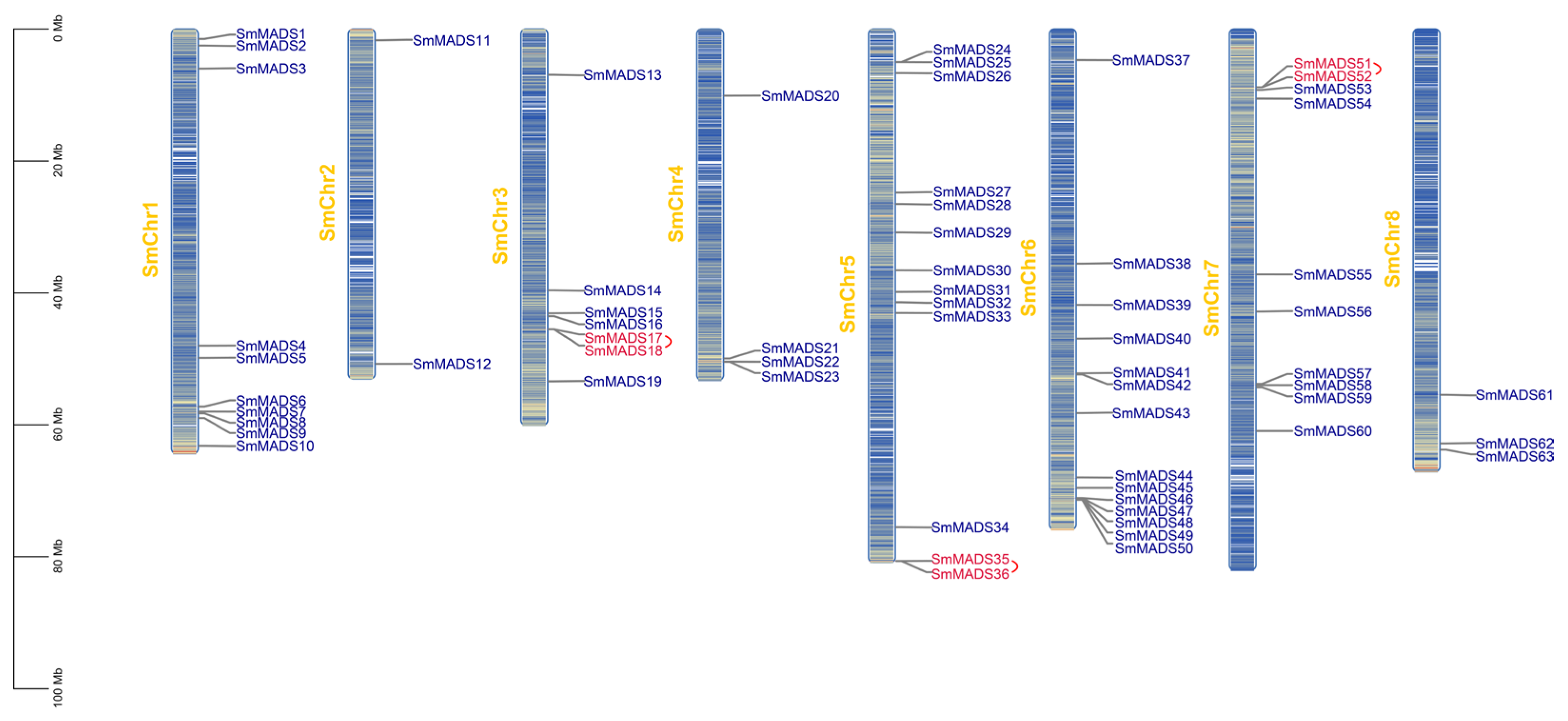
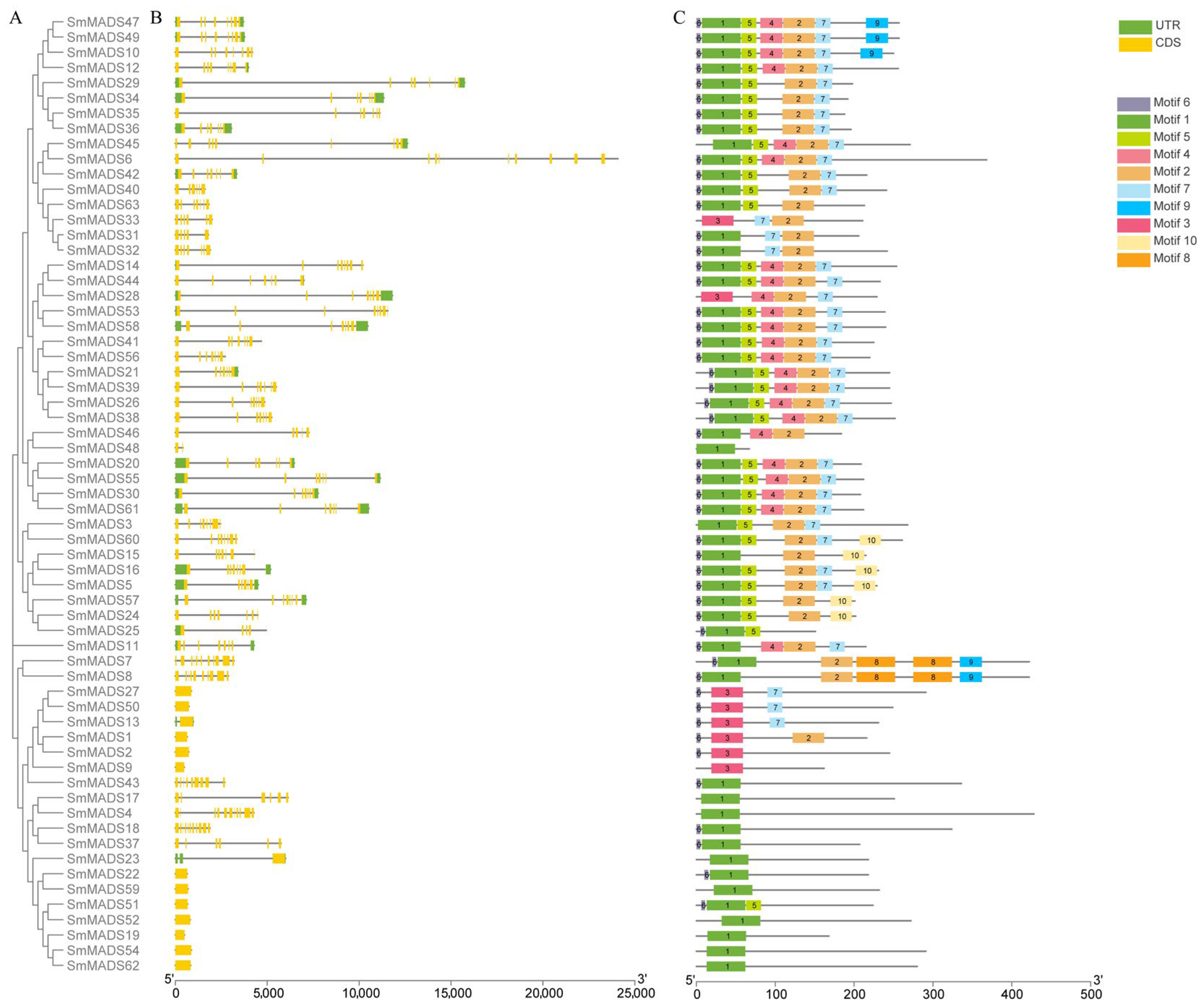

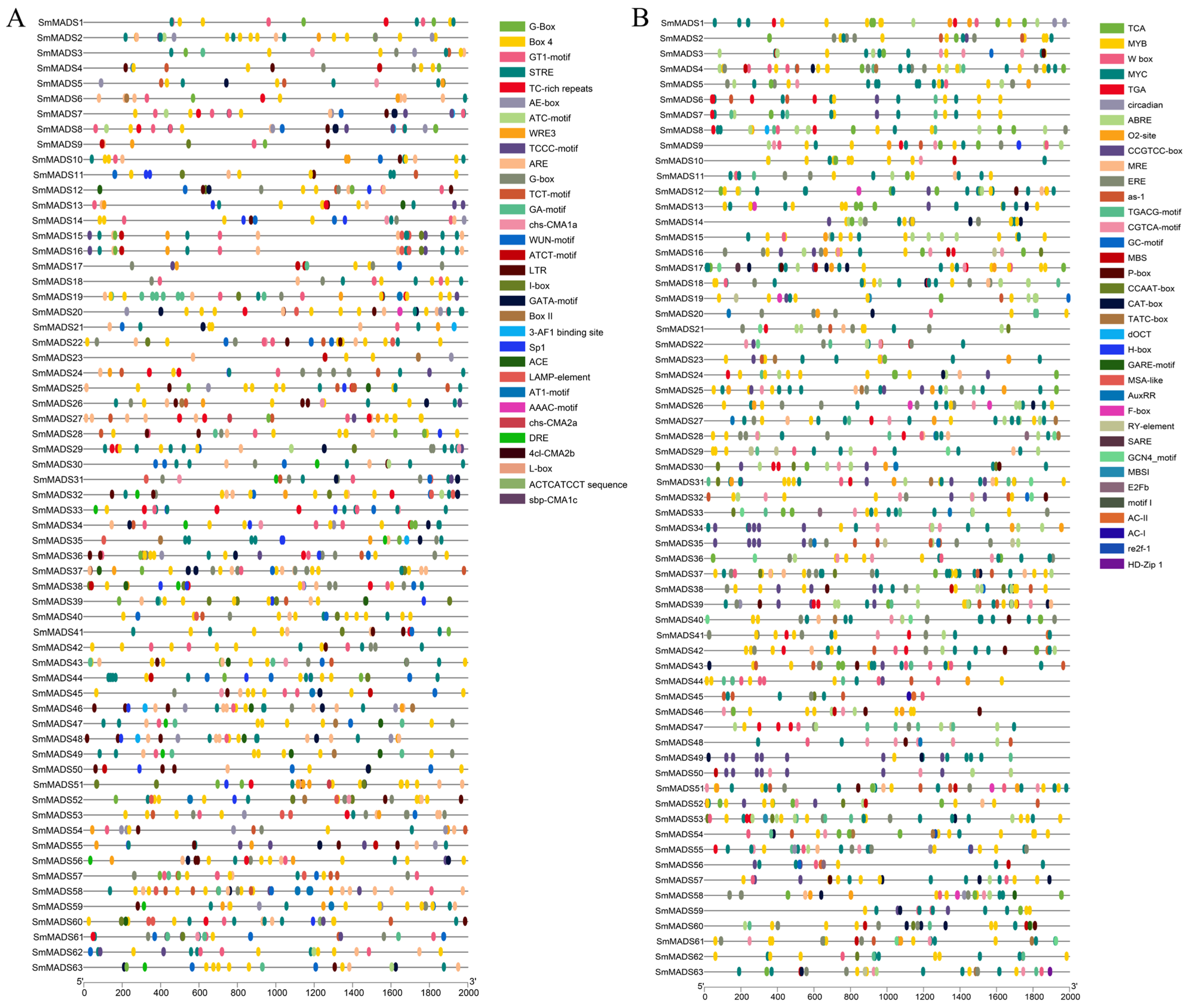

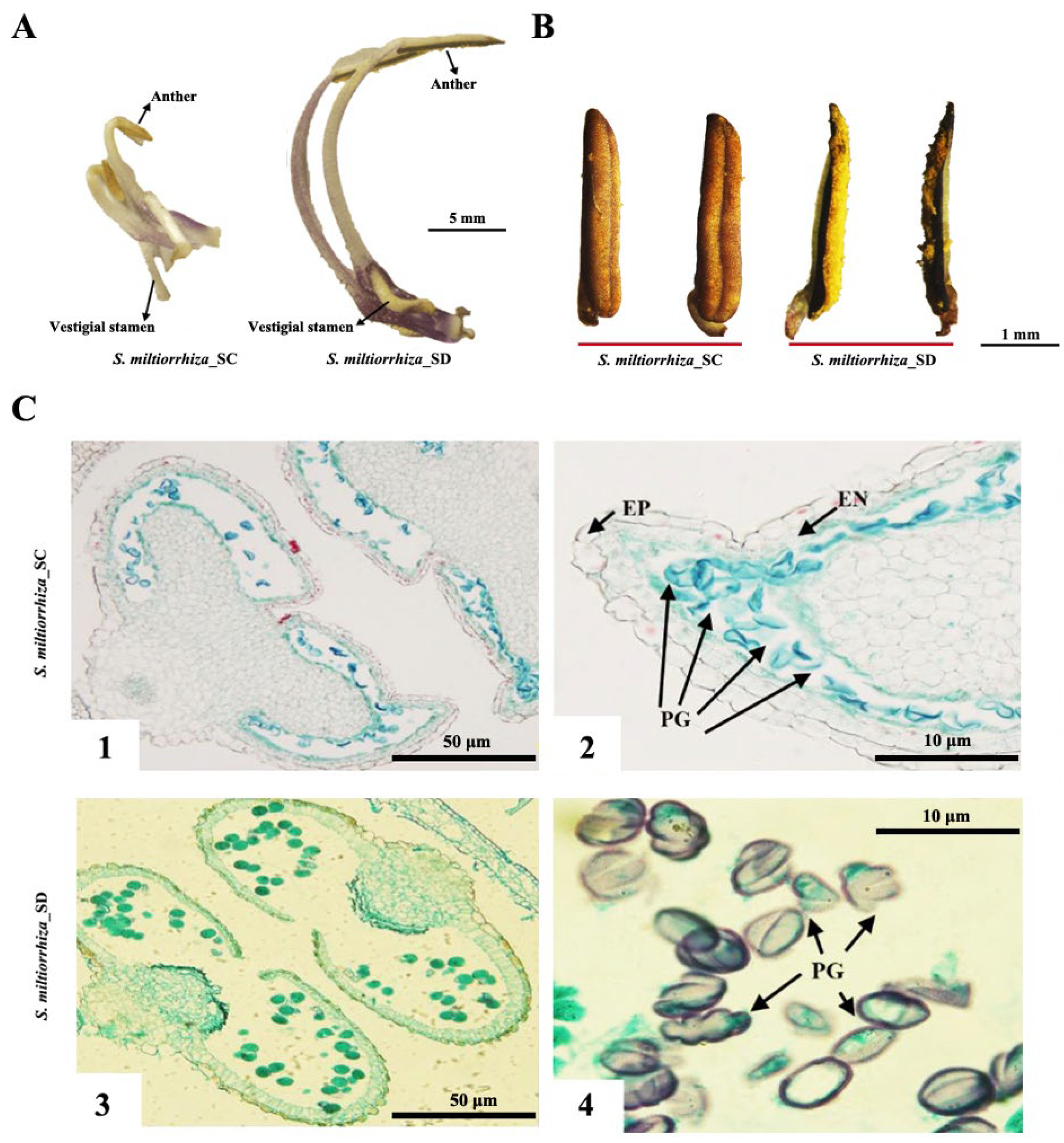
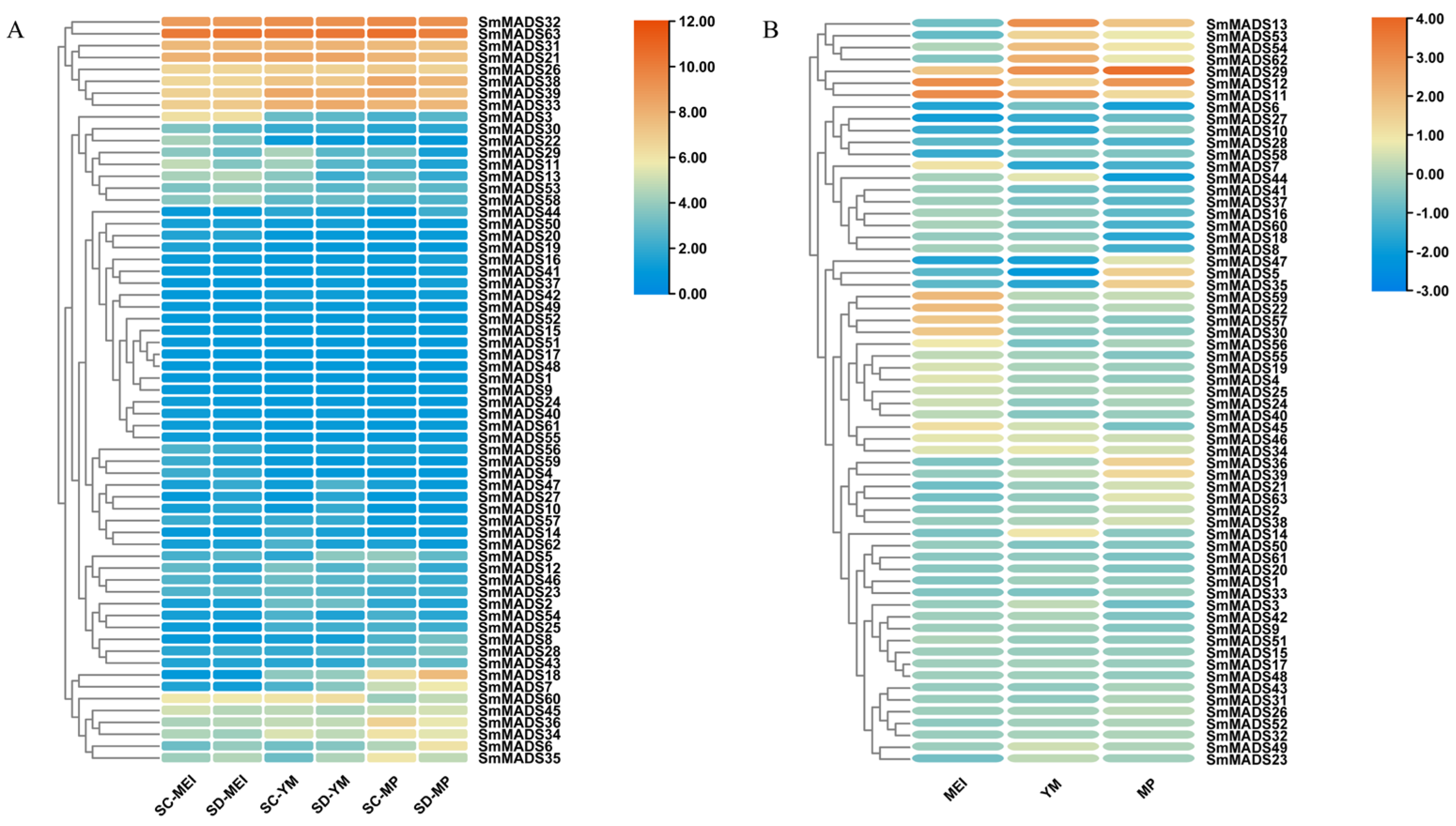
| Gene Name | Gene ID | Gene Start | Gene End | Protein Length | MW (kDa) | pI | Exon | Subcellular Localization |
|---|---|---|---|---|---|---|---|---|
| SmMADS1 | SmiChr010159.1 | 1,485,362 | 1,486,009 | 215 | 24.15 | 9.44 | 1 | Nucleus |
| SmMADS2 | SmiChr010237.1 | 2,485,729 | 2,486,463 | 244 | 26.91 | 8.78 | 1 | Nucleus |
| SmMADS3 | SmiChr010463.1 | 5,985,425 | 5,987,880 | 267 | 29.08 | 6.02 | 8 | Nucleus |
| SmMADS4 | SmiChr012432.1 | 47,986,871 | 47,991,143 | 427 | 48.57 | 4.90 | 11 | Nucleus |
| SmMADS5 | SmiChr012518.1 | 49,853,737 | 49,858,251 | 228 | 25.79 | 5.74 | 7 | Nucleus |
| SmMADS6 | SmiChr013041.1 | 57,213,037 | 57,237,118 | 367 | 41.27 | 8.76 | 11 | Nucleus |
| SmMADS7 | SmiChr013114.1 | 57,973,959 | 57,977,155 | 421 | 48.54 | 5.40 | 12 | Nucleus |
| SmMADS8 | SmiChr013140.1 | 58,250,724 | 58,253,616 | 421 | 48.19 | 5.24 | 10 | Nucleus |
| SmMADS9 | SmiChr013188.1 | 58,984,444 | 58,984,929 | 161 | 18.93 | 9.07 | 1 | Nucleus |
| SmMADS10 | SmiChr013568.1 | 63,166,262 | 63,170,460 | 249 | 28.74 | 8.82 | 9 | Nucleus |
| SmMADS11 | SmiChr020206.1 | 1,687,838 | 1,692,129 | 214 | 24.82 | 9.59 | 8 | Nucleus |
| SmMADS12 | SmiChr022579.1 | 50,749,433 | 50,753,421 | 255 | 29.21 | 6.71 | 8 | Nucleus |
| SmMADS13 | SmiChr030457.1 | 6,931,586 | 6,932,576 | 230 | 26.15 | 9.08 | 2 | Nucleus |
| SmMADS14 | SmiChr032079.1 | 39,590,711 | 39,600,916 | 253 | 29.35 | 9.23 | 8 | Nucleus |
| SmMADS15 | SmiChr032342.1 | 43,073,819 | 43,078,127 | 214 | 24.08 | 6.86 | 7 | Nucleus |
| SmMADS16 | SmiChr032371.1 | 43,524,700 | 43,529,892 | 230 | 25.94 | 6.94 | 8 | Nucleus |
| SmMADS17 | SmiChr032483.1 | 45,482,820 | 45,488,961 | 250 | 28.43 | 8.90 | 6 | Nucleus |
| SmMADS18 | SmiChr032484.1 | 45,496,314 | 45,498,200 | 323 | 36.59 | 5.38 | 11 | Nucleus |
| SmMADS19 | SmiChr033147.1 | 53,409,971 | 53,410,474 | 167 | 19.26 | 8.36 | 1 | Nucleus |
| SmMADS20 | SmiChr040450.1 | 10,096,933 | 10,103,415 | 208 | 23.97 | 9.10 | 7 | Nucleus |
| SmMADS21 | SmiChr042485.1 | 49,933,469 | 49,936,886 | 244 | 27.87 | 9.07 | 7 | Nucleus |
| SmMADS22 | SmiChr042537.1 | 50,422,600 | 50,423,253 | 217 | 24.31 | 6.40 | 1 | Nucleus |
| SmMADS23 | SmiChr042539.1 | 50,444,332 | 50,450,331 | 217 | 24.11 | 10.15 | 3 | Nucleus |
| SmMADS24 | SmiChr050234.1 | 4,973,889 | 4,978,379 | 201 | 22.73 | 5.49 | 7 | Nucleus |
| SmMADS25 | SmiChr050236.1 | 4,985,289 | 4,990,240 | 150 | 16.83 | 9.48 | 5 | Nucleus |
| SmMADS26 | SmiChr050368.1 | 6,663,001 | 6,667,860 | 246 | 28.40 | 9.57 | 7 | Nucleus |
| SmMADS27 | SmiChr051941.1 | 24,790,931 | 24,791,803 | 290 | 33.84 | 9.31 | 1 | Nucleus |
| SmMADS28 | SmiChr052086.1 | 26,494,694 | 26,506,514 | 228 | 26.32 | 8.26 | 8 | Nucleus |
| SmMADS29 | SmiChr052419.1 | 30,819,767 | 30,835,514 | 197 | 22.36 | 5.81 | 7 | Nucleus |
| SmMADS30 | SmiChr052857.1 | 36,559,133 | 36,566,908 | 207 | 24.32 | 9.41 | 7 | Nucleus |
| SmMADS31 | SmiChr053058.1 | 39,835,853 | 39,837,660 | 205 | 23.93 | 9.20 | 5 | Nucleus |
| SmMADS32 | SmiChr053148.1 | 41,413,138 | 41,415,040 | 241 | 28.18 | 9.60 | 7 | Nucleus |
| SmMADS33 | SmiChr053244.1 | 43,027,138 | 43,029,149 | 210 | 24.56 | 5.11 | 6 | Nucleus |
| SmMADS34 | SmiChr054722.1 | 75,497,647 | 75,508,993 | 191 | 21.78 | 6.76 | 7 | Nucleus |
| SmMADS35 | SmiChr055132.1 | 80,642,424 | 80,653,561 | 187 | 21.13 | 8.21 | 7 | Nucleus |
| SmMADS36 | SmiChr055133.1 | 80,660,607 | 80,663,672 | 195 | 22.45 | 8.20 | 7 | Nucleus |
| SmMADS37 | SmiChr060209.1 | 4,683,105 | 4,688,854 | 206 | 23.40 | 8.97 | 6 | Nucleus |
| SmMADS38 | SmiChr061372.1 | 35,548,758 | 35,554,001 | 251 | 29.43 | 9.08 | 7 | Nucleus |
| SmMADS39 | SmiChr061672.1 | 41,801,645 | 41,807,139 | 244 | 28.17 | 9.02 | 7 | Nucleus |
| SmMADS40 | SmiChr061960.1 | 46,937,821 | 46,939,442 | 240 | 28.00 | 6.84 | 6 | Nucleus |
| SmMADS41 | SmiChr062294.1 | 52,175,555 | 52,180,240 | 224 | 25.94 | 9.47 | 8 | Nucleus |
| SmMADS42 | SmiChr062306.1 | 52,366,574 | 52,369,925 | 215 | 24.68 | 8.28 | 7 | Nucleus |
| SmMADS43 | SmiChr062755.1 | 58,203,258 | 58,205,954 | 335 | 38.56 | 6.02 | 9 | Nucleus |
| SmMADS44 | SmiChr063526.1 | 68,122,359 | 68,129,359 | 232 | 26.77 | 9.21 | 7 | Nucleus |
| SmMADS45 | SmiChr063695.1 | 69,688,073 | 69,700,712 | 270 | 30.90 | 6.64 | 9 | Nucleus |
| SmMADS47 | SmiChr063823.1 | 71,111,091 | 71,114,807 | 256 | 28.85 | 7.75 | 8 | Nucleus |
| SmMADS48 | SmiChr063826.1 | 71,136,933 | 71,137,349 | 66 | 7.63 | 10.01 | 2 | Nucleus |
| SmMADS49 | SmiChr063828.1 | 71,151,764 | 71,155,538 | 256 | 28.85 | 7.75 | 8 | Nucleus |
| SmMADS50 | SmiChr063850.1 | 71,360,773 | 71,361,519 | 248 | 28.94 | 9.44 | 1 | Nucleus |
| SmMADS51 | SmiChr070750.1 | 8,813,120 | 8,813,791 | 223 | 24.89 | 9.34 | 1 | Nucleus |
| SmMADS52 | SmiChr070751.1 | 8,816,961 | 8,817,776 | 271 | 28.86 | 7.80 | 1 | Nucleus |
| SmMADS53 | SmiChr070801.1 | 9,225,527 | 9,237,091 | 238 | 27.38 | 8.87 | 8 | Nucleus |
| SmMADS54 | SmiChr070926.1 | 10,535,231 | 10,536,103 | 290 | 31.82 | 8.20 | 1 | Nucleus |
| SmMADS55 | SmiChr073037.1 | 37,186,399 | 37,197,551 | 211 | 24.10 | 9.22 | 7 | Nucleus |
| SmMADS56 | SmiChr073378.1 | 42,810,566 | 42,813,278 | 219 | 25.21 | 9.57 | 8 | Nucleus |
| SmMADS57 | SmiChr074083.1 | 53,784,259 | 53,791,389 | 200 | 22.81 | 9.66 | 9 | Nucleus |
| SmMADS58 | SmiChr074093.1 | 53,967,203 | 53,977,684 | 239 | 27.58 | 9.38 | 9 | Nucleus |
| SmMADS59 | SmiChr074108.1 | 54,295,919 | 54,296,614 | 231 | 25.54 | 5.75 | 1 | Nucleus |
| SmMADS60 | SmiChr074429.1 | 60,910,555 | 60,913,901 | 260 | 29.32 | 8.65 | 8 | Nucleus |
| SmMADS61 | SmiChr082309.1 | 55,443,038 | 55,453,573 | 211 | 24.18 | 9.49 | 8 | Nucleus |
| SmMADS62 | SmiChr082932.1 | 62,821,912 | 62,822,751 | 279 | 30.56 | 9.34 | 1 | Nucleus |
| SmMADS63 | SmiChr083047.1 | 63,750,692 | 63,752,525 | 212 | 24.93 | 6.51 | 7 | Nucleus |
Disclaimer/Publisher’s Note: The statements, opinions and data contained in all publications are solely those of the individual author(s) and contributor(s) and not of MDPI and/or the editor(s). MDPI and/or the editor(s) disclaim responsibility for any injury to people or property resulting from any ideas, methods, instructions or products referred to in the content. |
© 2023 by the authors. Licensee MDPI, Basel, Switzerland. This article is an open access article distributed under the terms and conditions of the Creative Commons Attribution (CC BY) license (https://creativecommons.org/licenses/by/4.0/).
Share and Cite
Chai, S.; Li, K.; Deng, X.; Wang, L.; Jiang, Y.; Liao, J.; Yang, R.; Zhang, L. Genome-Wide Analysis of the MADS-box Gene Family and Expression Analysis during Anther Development in Salvia miltiorrhiza. Int. J. Mol. Sci. 2023, 24, 10937. https://doi.org/10.3390/ijms241310937
Chai S, Li K, Deng X, Wang L, Jiang Y, Liao J, Yang R, Zhang L. Genome-Wide Analysis of the MADS-box Gene Family and Expression Analysis during Anther Development in Salvia miltiorrhiza. International Journal of Molecular Sciences. 2023; 24(13):10937. https://doi.org/10.3390/ijms241310937
Chicago/Turabian StyleChai, Songyue, Kexin Li, Xuexue Deng, Long Wang, Yuanyuan Jiang, Jinqiu Liao, Ruiwu Yang, and Li Zhang. 2023. "Genome-Wide Analysis of the MADS-box Gene Family and Expression Analysis during Anther Development in Salvia miltiorrhiza" International Journal of Molecular Sciences 24, no. 13: 10937. https://doi.org/10.3390/ijms241310937
APA StyleChai, S., Li, K., Deng, X., Wang, L., Jiang, Y., Liao, J., Yang, R., & Zhang, L. (2023). Genome-Wide Analysis of the MADS-box Gene Family and Expression Analysis during Anther Development in Salvia miltiorrhiza. International Journal of Molecular Sciences, 24(13), 10937. https://doi.org/10.3390/ijms241310937






